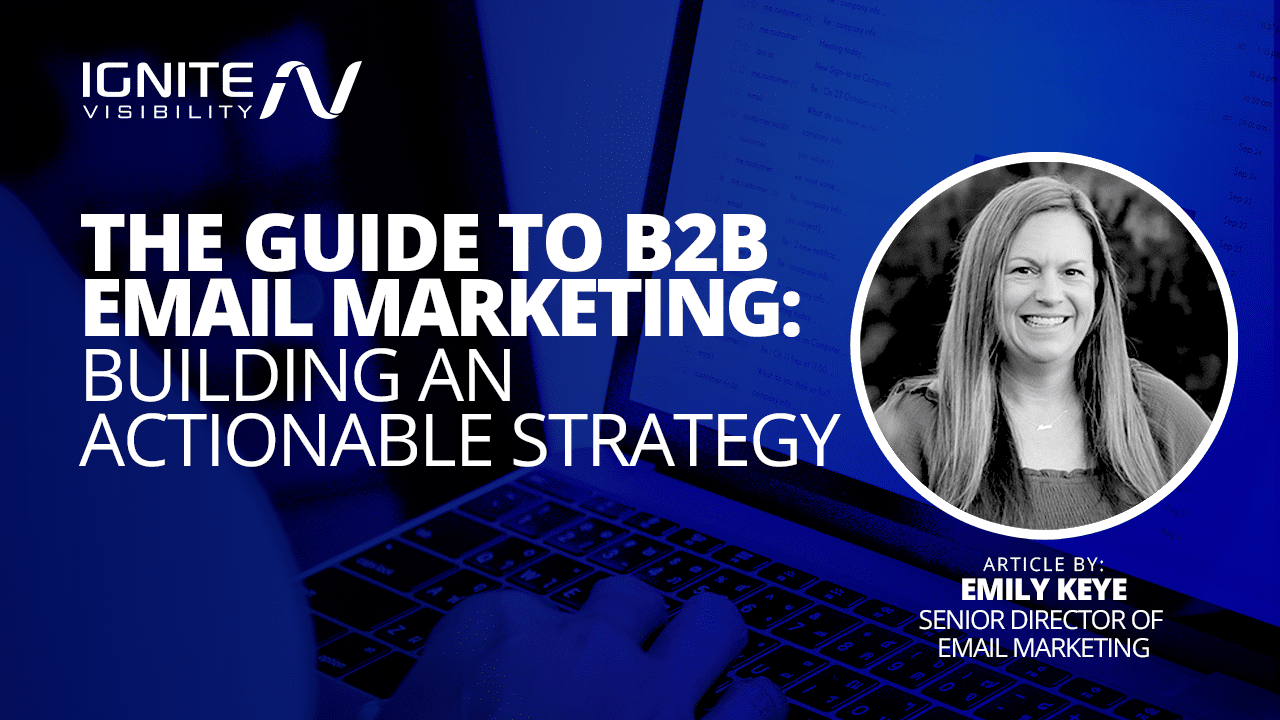
Email remains one of the best marketing tactics for ROI. Businesses see a return of $36 for every $1 spent! It’s hard to beat that kind of value, and B2B email marketing can potentially drive prospects down your marketing funnel. If you deliver value to the inbox, you’ll see results, from acquiring new customers to upselling existing ones.
While email marketing is one of the oldest forms of digital marketing, you should reset your ideas about it. Too often, companies don’t give it the attention or investment it deserves. In fact, only 59% of B2B companies use it, which means there is a lot of opportunity for your brand to gain some wins here.
B2B email marketing can fuel revenue. All you need is a strategy, a list of B2B email marketing best practices to follow, and inspiration.
Let’s dive in.
What You’ll Learn
- What is B2B Email Marketing?
- The Benefits of B2B Email Marketing
- 10 Steps to Building a Successful B2B Email Marketing Strategy
- B2B Email Marketing Best Practices
- 10 B2B Email Marketing Examples
- B2B Email Marketing FAQs
Our Expert Insights on Email Marketing
Our Senior Director of Email Marketing, Emil Keye says, “In the realm of digital marketing, B2B email marketing stands as an indispensable pillar of success. The importance of crafting compelling, personalized email campaigns cannot be overstated. It’s not just about reaching inboxes; it’s about building relationships and driving business growth, no matter what industry you’re in.”
To excel in B2B email marketing, it’s essential to segment your audience effectively. By understanding their specific pain points, industry nuances, and interests, you can tailor your emails to deliver highly relevant content.
The key to success lies in delivering engaging content that addresses the unique needs of your B2B audience. Your emails should provide valuable insights, educate your readers, and offer actionable solutions, establishing your brand as a trusted industry resource.
Continual improvement is the name of the game in B2B email marketing. A/B testing is your ally. Experiment with different subject lines, visuals, and calls to action to refine your email campaigns and enhance their effectiveness.
Remember, B2B email marketing isn’t just about sending messages; it’s about forging connections and providing real value. By following these tips throughout the blog and taking action, you can unlock the full potential of B2B email marketing to drive tangible results.
What is B2B Email Marketing?
B2B email marketing describes using this tactic to create leads and sales for your company. It can have many use cases.
Email marketing for business-to-business is a necessary piece of your marketing strategy. The reason why email marketing is so important has much to do with its attributes (and those ROI stats!). The necessity comes from its effectiveness.
Those you’re emailing have opted in to hear from you, so it’s not a cold email that sales would send on a one-to-one basis. Plus, they arrive in a place (the inbox) where your prospects spend lots of time. It’s an always-on channel because we receive and view emails from anywhere.
It also can engage or reengage potential or dormant customers. For example, in a B2B email marketing nurture series, you craft a sequence of emails that offer knowledge and insights. The recipient then spends more time on your website and begins to form an opinion of your brand as knowledgeable and credible.
Who Needs B2B Email Marketing?
The short answer is that every company, regardless of size or industry could benefit from B2B email marketing.
- Email is a conversation starter. It tells prospects or customers how you can help them solve their biggest challenges.
- It’s the number one owned media channel for content distribution. If you’re regularly producing content on your website, email is a proven way to get it to those needing it.
For companies that are B2B, the approach to email marketing is different than B2C. Here’s how.
B2B vs. B2C Email Marketing
Simply put, the biggest difference between B2B and B2C email marketing is looking at how people make purchases.
Many experts state that only B2C customers make emotional buying decisions. B2B buyers do as well, but they have many other qualifiers to meet.
For example, emotions are tied to B2B purchases, as people need solutions to solve problems. They are overwhelmed, disappointed, or exhausted by this challenge. So, there is emotion behind their decisions. They also have to choose a product that meets the needs of many, is on budget, easy to implement, and can provide ROI.
Other things that set these two apart include:
- Buying Cycles: They are much longer in B2B than consumers deciding to buy a sweater. The more expensive the purchase, the longer the cycle. Thus, emails to get them through the funnel aren’t usually one-offs.
- More Buyers: The average buying group in B2B is six to 10 people. It’s purchasing by committee, so you have many people to convince. They may all have different motivations and goals, too.
- Content Focus: In B2B emails, you’re talking to people about improving efficiency, reducing costs, and saving time and how features of your product achieve this. In B2C, the content is sales-focused and all about getting a consumer to buy, buy, buy.
Now that we’ve covered the basics, let’s discuss the benefits of B2B email marketing.
6 Benefits From Effective B2B Email Marketing
You already know the exceptional ROI you can expect, but there are lots of other ways that demonstrate why email marketing is important.
1. Control Messaging and Targeting
As an owned channel, you get all the control. You can craft specific content for different personas so it’s relevant to them.
You can also decide what it looks like and how to make certain areas pop to drive clicks.
According to the Content Marketing Institute 2024 B2B Content Marketing report, it’s the leading owned content distribution channel.
2. Support Lead Nurturing
Unfortunately, most B2B leads don’t become sales-ready for some time; They consume lots of content before this step. And that amount of consumed content increased by 18.8% in the last year.
It drives their purchase, and email keeps them learning and considering. Since email tracking help you to check their opens and clicks, you can use these actions for lead scoring, eventually marking them as qualified for sales.
3. Improve Customer Loyalty and Retention
Email is also a good tactic for existing customers. It’s essential for all companies whether you’re selling services or products to build a loyal customer base.
B2B email applications might include:
- Welcome emails
- Onboarding email series to ensure adoption
- Cross-selling and upselling opportunities
- Customer-only promotions
- General check-ins
- And more
4. Personalized Messaging
The ability to segment your lists ensures you can personalize the content based on several factors—industry, user type, products used, or needs.
The more relevant a message is, the more likely the addressee will open and click.
Companies creating segmented messaging see a 760% increase in revenue from these efforts.
5. Educate Prospects and Customers
Email is also a vehicle for sharing learnings and resources.
This would include emails sent to customers that reference a business’ learning platform or training materials and thought leadership content that builds your credibility in the industry.
6. Gain Insight Into Customer Motivations and Needs
How people interact with the many types of emails you send enables you to know them better.
Looking at the data, you can conclude things like topics that interest them, types of content they like, how often they interact with your content, and more.
Build an Actionable B2B Email Marketing Strategy
You’ll need to develop a strategy to use email marketing for your small business effectively. Follow these steps to create one that will deliver results.
Step 1: Start Building Your Email List Organically
Before you can send campaigns, you’ll need to build your opted-in email list. Many tactics can support this goal, including:
- Gated content or tools offers that require contact information (make sure the form has a checkbox or note that says they agree to receive emails from your company)
- Newsletter subscription sign-up offers (place these on your website and social media profiles)
- Adding “Email to a colleague” language in emails that encourages people to share them and opt-in
- Promoting an online contest that people enter by giving their contact information
- Adding email subscription offers at the end of videos on your YouTube page
Step 2: Qualify and Score B2B Email Marketing Leads
Email marketing is trackable; how receivers respond drives what happens next for those leads. Based on these actions, you can qualify and score these prospects.
Qualifying means marketing reviews the lead’s fit with your ideal customer persona or other criteria. Doing this helps you focus on those most likely to need and purchase your product.
Lead scoring as part of email is a methodology for ranking a prospect’s readiness for sales. It assigns points to a contact depending on opens and clicks. You define the score based on responses, with some being greater than others.
For example, a person who opens an email with a case study and then clicks to read it would yield a high score. Case studies are bottom-funnel content that most buyers review when they are nearing a decision.
Step 3: Segment Your Email List
We’ve briefly touched on email segmentation and its ability to drive personalization. Executing this can be challenging, as it depends on the information you have about each contact.
You’ll need to define what will be most critical in segmenting and then work to collect that information. Some ways to segment include:
- Firmographics (e.g., geography, size, organization type, industry, products they use)
- Buyer persona or title
- Business needs
- Behavior (e.g., interactions with your brand, lead scoring)
- Funnel stage
- Active vs. inactive contacts
- How you acquired their email (e.g., webinar attendees, people who signed up with your company at a trade show)
Proper email segmentation delivers higher performance because the conversation becomes more personal. It’s a sign that you understand the customer or prospect and provide valuable information to them.
Step 4: Craft Creative Subject Lines
Your subject line is your opener and hook. If it’s not appealing, users will keep scrolling. It needs to be short, snappy, and convey value.
B2B buyers receive tons of emails daily, so your subject line must speak to them and stand out. Some subject line best practices include:
- Evoke curiosity by using a question as the subject line.
- Display urgency if it’s an offer.
- Personalize it with the addressee’s name.
- Keep character count around 50-70 to ensure nothing gets lost on mobile, which is where 46% of email opens occur.
- Use contextual subject lines that set up expectations about the content in your email.
- Make the sender address an actual person versus generic ones like hello@ or no-reply.
- Add some levity and humor to the subject line to get attention.
Step 5: Select a Customer Relationship Management Platform (CRM)
You’ll need a CRM tool to manage all your email lists, lead scoring, and gather more information about email recipients.
You have many choices in the market with varying functionality. Consider what you expect a CRM to be able to do, like integrate with your email marketing tool. Also, look for special features that help you segment easily. Finally, be sure that it’s tracking all their interactions accurately.
Step 6: Start With a Welcome Series
Keeping customers engaged is essential for long-term retention. When you collect customer emails you can trigger a welcome email series. Depending on your product or service, it could be a general welcome set of emails that offer more information about the product and how to use it.
Take advantage of the probable engagement that a user has after becoming a customer. They are highly likely to open this email. Make sure it has key information for them to be successful, including how to contact support, where to find a knowledge base, a request to follow on social, a chance to join your newsletter list, and a link to relevant content.
Step 7: Curate a Specific Onboarding Sequence
The most common welcome emails are those for onboarding new customers. It’s also a consideration in the buying process, and 86% of people are likelier to stay loyal to a business that does it right.
Your onboarding nurture would include:
- User testimonials that highlight how well your solution works
- General welcome and information about future emails
- Contact information for customer success teams
- Links to your internal learning platform where they can find how-tos and more
- A series of bite-size video tutorials
- Gamification, such as people earning digital rewards for completing onboarding
- Feature-specific content for those currently available and coming soon
- FAQs
You could also develop a re-engagement onboarding for those customers who are decreasing usage. Tailor it to ensure they are aware of all the system can do.
Step 8: Define the Types of Emails You’ll Send
Email marketing can deliver all kinds of messages. The tactic is so versatile that it can help you achieve many marketing goals.
There’s no limit to the types of emails you can create as long as you have the content, strategy, and mechanics to make it work. Examples of email types include:
- Promoting premium content
- Distributing content through newsletters
- Introducing new products and services
- Announcing new features and functionality
- Delivering a special deal or promotion
- Inviting people to webinars and events
- Nurturing a prospect through a series of emails that range from top-funnel to bottom-funnel
- Showcasing case studies
- Bringing industry news to their attention
- Training, tutorials, and other customer-only exclusive content or events
Step 9: Automate Key Customer Interactions
Email automation is another vital part of your strategy. Your email marketing platform should eliminate much manual work, which is too time-consuming. Look for these automation features:
- Tracking interactions that would trigger other emails to send. For example, if someone downloads a top-funnel e-book, you may want to move them to a nurture series automatically. When prospects become customers, the welcome series would begin.
- Creating automated drip campaigns. Email technology allows you to set up automated drip campaigns that are sent to people as they enter a list based on criteria. Emails are then delivered based on a cadence; there can be deviations if the person takes a specific action.
- Autoresponders. After someone attends a webinar or downloads a resource, you’ll want your system to auto-send a response that thanks them, provides a link to the asset, and offers more content for them to peruse. In some instances, you may also want a bottom-funnel CTA for them to request a demo or make a purchase.
Step 10: Continuously Test and Measure Campaign Performance
The last pillar of your B2B email marketing strategy is testing and measuring.
A/B tests are a must-have. In most cases, you’ll try two or more subject lines and compare performance. This can help you craft more enticing ones.
The main email metrics to measure are open rates and click rates. They indicate engagement and are what feed into lead scoring.
Look at email marketing industry benchmarks to see how you’re doing. Review the analytics from a wide view. Then, break it down into types to see how segmentation, onboarding, invites, content offers, and promotions fair. Use what you learn to get better on every campaign.
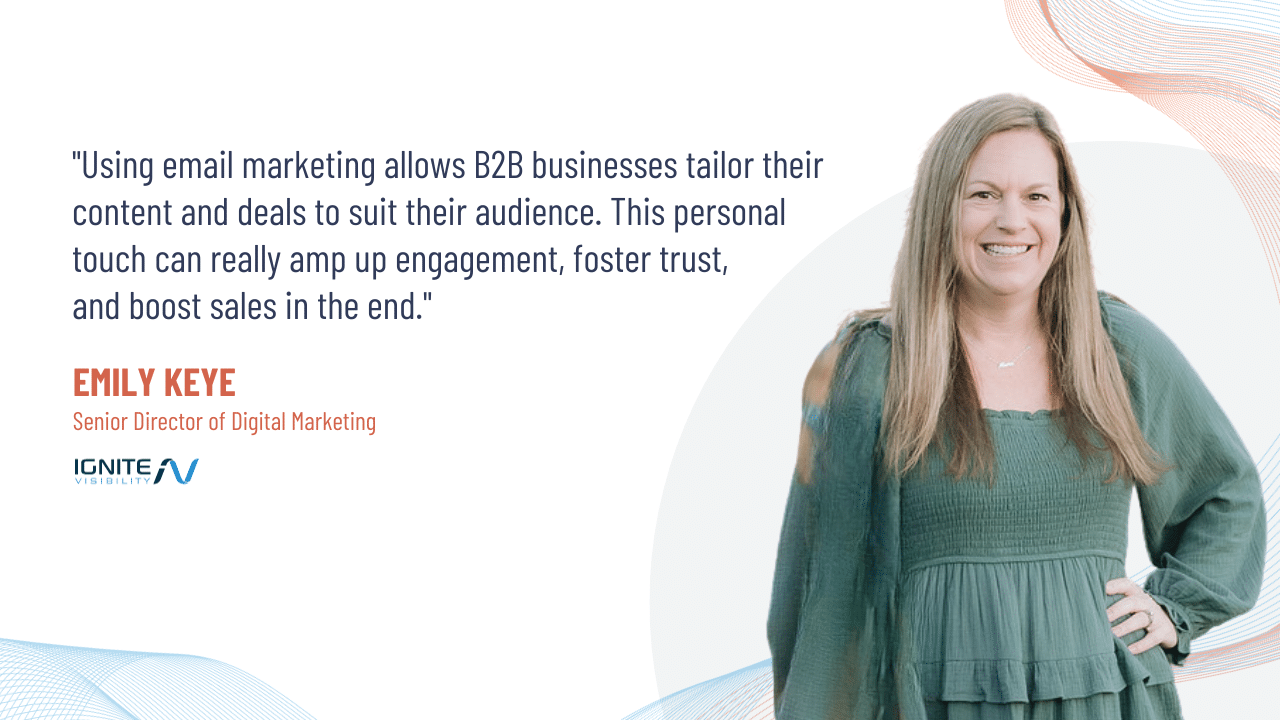
Emily Keye – Senior Director of Email Marketing
B2B Email Marketing Best Practices
Realize high ROI and engagement by following these best practices for B2B email marketing.
Experiment With Plain Text Emails
While B2B email design is often fancy and branded, using plain text emails has advantages.
There are no images to load or HTML code to render, so you don’t have to worry about how it will look on different email platforms. The benefits of using this option are:
- It’s more likely to make it past spam filters.
- Some people prefer it plain and simple.
- They don’t take up bandwidth like HTML emails do.
- Plain text emails work well in non-traditional inboxes, like smartwatches and gaming devices.
Craft Focused, Clever Calls to Action (CTAs)
The call to action or CTA may be the most critical copy in emails.
It needs to be relevant, clever, and persuasive. They should convey the value and what someone gets by clicking. Instead of using generic ones, align them more to buyer needs.
For example, when you send a follow-up email to someone who started a free trial, the CTA could be “Keep Using Product Name.”
Write Clear and Concise Copy
Emails are not a time to be long-winded. You’ve got to catch their attention fast and state your case.
Ensure each word has meaning and is helpful for the customer. Don’t spend time on fluff or unnecessary commentary.
Write email copy that’s for the subscriber and contextualizes where they are in the customer journey.
Stay True to Your B2B Brand Tone and Voice
Every business should have a brand tone and voice. It’s the foundation for all your content, defined by attributes, syntax, and word choice.
Email is a unique communication channel that’s short and sweet. However, it should remain true to tone and voice.
Within your brand and voice document, include parameters and tips for email specifically.
Get the Timing Right
When should you send your emails? There’s much debate on this question. Email studies have made conclusions about dates and times. A survey with marketer responses defined these as the best times and days:
- 9:00 am to 12:00 pm and 12:00 pm to 3:00 pm
- Tuesdays
Your best time and day may be different. You’ll get more insight on this as you send more emails.
Track this data and see what it says about when your prospects and customers are most likely to open messages.
Use Responsive Design
For HTML emails, you should build them with responsive design. It will automatically customize the layout based on the user’s device.
Most email platforms have templates that work like this. The designed email should render and look good no matter the screen size.
Stick With Images That Algin WIth Your Message
Images matter in terms of engagement. They also make the email size larger, so use them thoughtfully. Header images are the most common, and they should directly relate to the content. Other image ideas include:
- Headshots of presenters for webinars or in-person events
- Screenshots of features
- Sleek product pictures
- Covers of an e-book or white paper
- Embedded infographics
- Logos
- Animated GIFs
Next is the culmination of strategy and best practices with a look at some excellent B2B email marketing examples.
10 B2B Email Marketing Examples
Example 1: Buffer – Welcome Email
In this first email to new users, Buffer offers tips on using their tools and sets expectations that they’re always here to help.
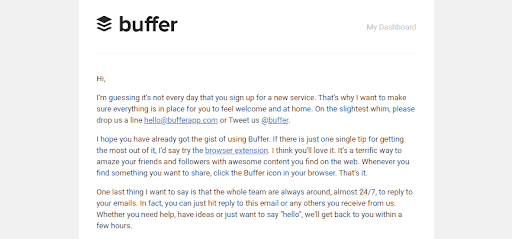
B2B Email Marketing – Welcome Email Example
Example 2: Asana – Feature Focus
The project management platform highlights how to create a task with empowering language and a screenshot.
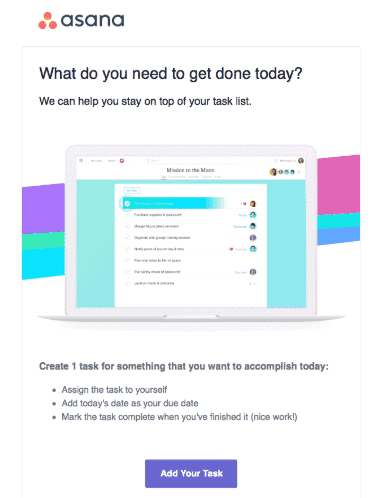
Example of a Feature Focus Email for B2B Company
Example 3: DocuSign – Answering an FAQ
Users of DocuSign frequently ask about the security of electronic signatures, and the company understands these concerns. They are answering the question before anyone asks it.
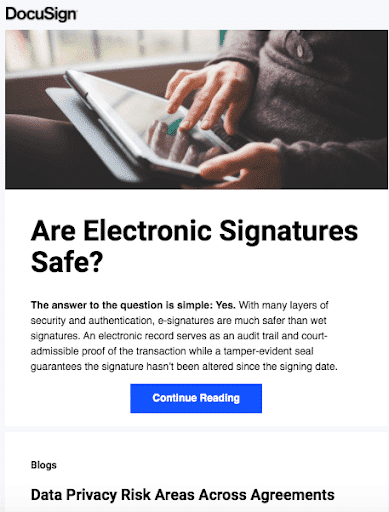
B2B Marketing Email – Answering FAQs
Example 4: Salesforce – Blog Highlights
Salesforce is a content machine, so they, of course, use email to distribute it. In this example, they have a featured post with a fun image along with teasers for other content.
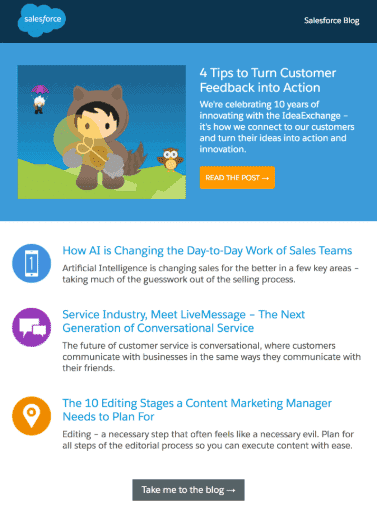
Example of Blog Highlights for a B2B Company
Example 5: Gallup – Autoresponder Follow-Up
Emails after an action are a great way to keep people engaged. In this example, the email provides the link to the asset. Then, they add a section on how they can help, focusing on specific needs.
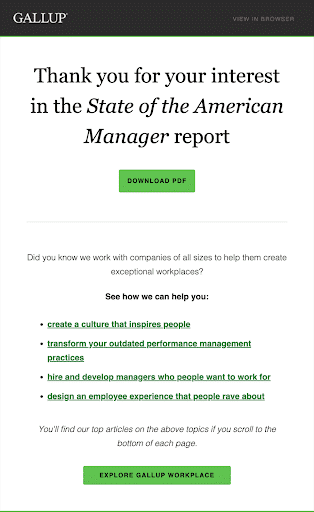
Example of a Follow-Up Autoresponder Email
Example 6: Webflow – Event Promotion
Promoting events via email should be exciting and build anticipation. In this example, Webflow gives its customers a bulleted list of why they should attend. It’s simple, and the CTA includes “it’s free!”
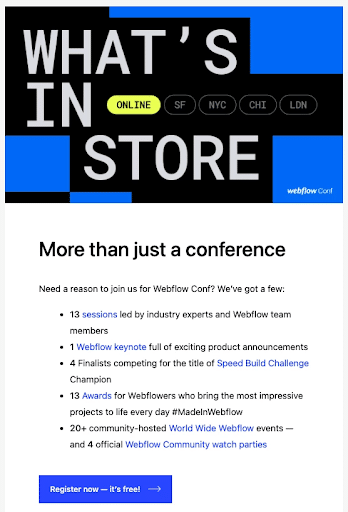
B2B Email Marketing – Event Promotion
Example 7: Zapier – Survey Email
Getting feedback from customers can drive many decisions. In this option, Zapier asks a trial user about their experience. What they learn from this could inform acquisition strategies and onboarding.
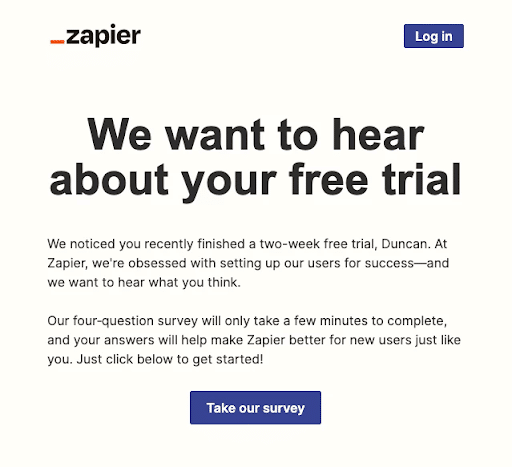
Example of a Survey Email
Example 8: Grammarly – Reengagement
In this B2B email marketing example, Grammarly checks in with a user who hasn’t been active. It reminds them of the value of using their tool.
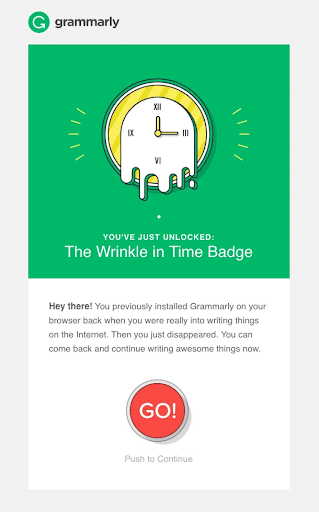
Reengagement Email Tactic – B2B Email Marketing
Example 9: Merkle – Premium Content Offer
Email is the top distribution channel for premium content. In this approach, Merkle uses the image of the white paper and a summary of what’s inside to pique interest.
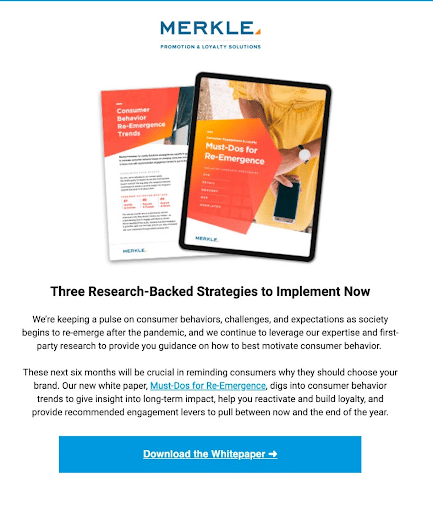
Premium Content Offer – Email Example
Example 10: Animalz – Case Study Email
Case studies are a great way to nudge prospects to a decision. They highlight what benefits and results a fellow customer experienced and often include a call-out quote or the customer’s picture.
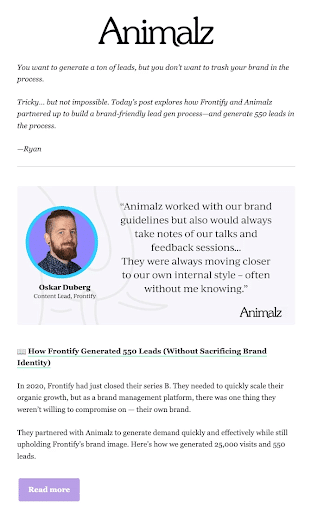
Case Study Testimonial – B2B Email Marketing
B2B Email Marketing FAQs
1. How often should you send emails?
There’s no magic cadence for this. It depends on the content of the email and its senders. Determine what an appropriate frequency that won’t seem annoying.
2. Who should marketing emails come from?
It’s best to use the real email address of someone they may recognize. You could also create a faux email from an address that looks like it’s an actual person. Avoid using generic ones, as they are most likely to get caught by spam filters.
3. What is email deliverability?
This is a metric that defines how many emails the system successfully delivered. Those that did not make it would either have a soft or hard bounce. A soft bounce is a temporary delivery issue. A hard bounce is permanent, meaning the email is no longer valid.
4. What is the CAN-SPAM Act?
The CAN-SPAM (Controlling the Assault of Non-Solicited Pornography And Marketing) law requires business emails to include:
- A listed physical address
- An easy way to unsubscribe
- From, To, and Reply fields that are clear
Those you’re sending emails to must opt-in to receive them. Failure to follow these rules can result in fines. Read more about the Act here.
Achieve B2B Email Marketing Success with Ignite Visibility
Managing email campaigns and ensuring they drive leads and revenue requires a lot of attention and expertise. Email marketing for small businesses can be more successful with the right partner.
Whether you’re a home services business, run an autobody shop, have a healthcare practice, or run an ecommerce company, we’re here to help.
Ignite Visibility can help you:
- Build and grow your opt-in email list
- Set up behaviorally triggered and data-driven automation
- Craft cohesive campaigns that drive results
- And more
Our team of email marketing gurus is here to help. From strategy to execution, we’ve got you covered.
Explore our services and get in touch to chat.